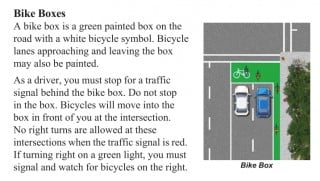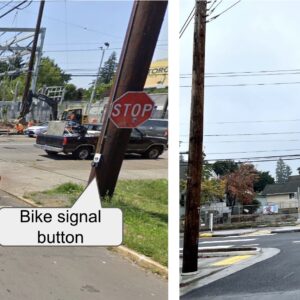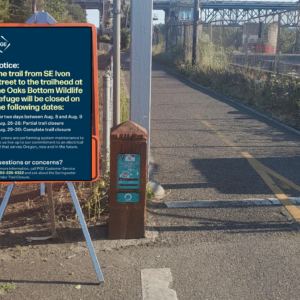We didn’t either.
Neither did Ray Thomas, the man who literally wrote the book on Oregon bike law (and has personally written and/or lobbied for many of them). Neither did Rob Sadowsky, the executive director of the largest bicycle advocacy organization in the state, or Noel Mickelberry, the leader of Oregon Walks.
“It caught us totally off guard,” Sadowsky shared with me this morning, “And it points to a lack of collaboration.”
This is a big deal because the 84-page Oregon Driver’s Manual impacts how people learn to behave on the road. It’s probably the one source of traffic law nearly every driver has consulted at least once and it’s used in court to justify behaviors both right and wrong. Making sure the driver’s manual presents information accurately and from a variety of perspectives — especially the most vulnerable road users — is a key component of the gradual march toward Vision Zero.
Suffice it to say I was surprised to get an email from Thomas about this last Friday (June 26th). After hearing about the revision in passing from a friend on a bike ride, he reached out local advocates wondering if anyone had been given the opportunity to weigh in on the process. Thomas was exasperated in his email because Friday the 26th was also the last day ODOT was accepting feedback.
Advertisement
“I only found out about the revision almost by accident and I am glad I did,” Thomas wrote, “because under Oregon law many judges allow the text of the Oregon Driver Manual into evidence against an injured vulnerable user.”
“I only found out about the revision almost by accident and I am glad I did… These Driver Manuals are used against my injured clients in court all the time.”
— Ray Thomas, lawyer
The manual is not intended to have any legal authority (it says so right on the opening page), but that doesn’t stop judges and even police officers from using it as such. “These Driver Manuals are used against my injured clients in court all the time,” Thomas cautioned.
Thankfully, Thomas got his comments in on time (no word yet whether his suggestions will be incorporated). Below is just a sampling of his feedback:
-p. 20 says “bike lane” is a “solid white line” – however in many intersections the bike lane is a broken white line which is intended to indicate a “mixing zone”.
-p. 24 under “passing” fails to indicate that a driver may drive on the left side in a no passing zone when an “obstruction or condition exists making it necessary” “provided that a driver doing so shall yield the right of way to all vehicles travelling in the proper direction….” ORS 811.420(3)(b).
-p. 26. “Passing on the Right”. This section should include reference to ORS 811.415 (2)(c) which states that “overtaking and passing on the right is permitted if the overtaking vehicle is a bicycle that may safely make the passage under the existing conditions.”
– p. 29 and 30 “Turns” should state “You may turn across a bicycle lane after yielding the right of way. Do not move into a bicycle lane in preparation for a turn. Always check your mirrors and over your shoulder before turning, and if you don’t know, don’t go. You must also stop for pedestrians and bicyclists in crosswalks and yield to pedestrians and bicyclists on sidewalks.”
– p. 38 the manual includes this sentence: “Inexperienced bicyclists can be unpredictable.” It should be changed to, “You may not be able to predict a bicyclist’s intentions.”
I followed up with ODOT to find out more about their process for revising the manual. DMV spokesman David House said they treat it like any other publication update and don’t have a formal public comment period. “But we consider suggestions from the public, lawmakers, etc.,” he said.
When I asked him specifically who had reviewed the manual this time around he said it was a mix of staff from the DMV, ODOT’s Safety Division, law enforcement officials, and staff from other divisions within ODOT.
House added that they’ll accept feedback from the public at any time and will consider it “in the next review.” The best way to share your comments and suggestions, House advised, is to “use the contact information links on OregonDMV.com.”
I can appreciate that ODOT updates a lot of publications and that a formal public process for each of them could be cumbersome. But I think they need to slow down a bit and consider getting more feedback and perspectives on the Driver’s Manual — especially at a time when the public is clamoring for Vision Zero, traffic fatalities are up over 43% so far this year and we know that many people have complete disregard for safety and the law when they get behind the wheel.
The new version of the manual — which will hopefully include Ray Thomas’s suggestions — should start appearing at your local DMV by January 2016.
To see the current draft ODOT staff is currently revising, download this PDF.







Thanks for reading.
BikePortland has served this community with independent community journalism since 2005. We rely on subscriptions from readers like you to survive. Your financial support is vital in keeping this valuable resource alive and well.
Please subscribe today to strengthen and expand our work.
Getting the new version in ship shape is great, but unfortunately since Oregon basically never requires retesting most people (including police officers) are going off of what was in the drivers manual when they were 16 and first got a license, which might be 50 years ago. Regular retesting would go a long way towards people actually complying with laws and greater recognition of the meanings of newer control devices.
suggest that they add a blurb about keeping a safe passing distance from cyclists…
Yes! This is where I think Oregon would do well to adopt a standard distance, like most other states, instead of the guidance that gives me (at 6’4″) more passing clearance than most children. The other beauty of a fixed distance is that it can be measured: http://www.timesfreepress.com/news/local/story/2015/jun/07/3-feet-or-else/308339/
I did notice in this writing that the section on passing mentions to watch for pedestrians and bicyclists. That seems like a great place to incorporate your suggestion…
If the distance is at least six feet, I’d be okay with that. Three feet isn’t enough.
Wouldn’t argue with you on that one, but I’d be stoked if we could start by getting all states to adopt some measurable (and enforceable) standard:
http://www.ncsl.org/research/transportation/safely-passing-bicyclists.aspx
Better than 3 inches, which is what I get from people who don’t know any better.
Thanks for calling our attention to this Ray and Jonathan!
I am especially irked by the last quote Ray highlights:
“Inexperienced bicyclists can be unpredictable.”
And might add to Ray’s edit (without turning off the snark):
“You may not be able to predict a bicyclist’s intentions, nor they yours, and with potentially far greater consequences for them.”
Now we just need a way to get people to read the manual more than once in their lifetime. With all the changes in traffic laws I find it amazing that there is nothing done about ensuring that information gets out to drivers on a regular basis.
“I find it amazing”
Not amazing. Drivers (naturally) know what is safe. That is why we (ODOT) are comfortable continuing to set the speed limits at whatever the 85th percentile speed of those driving a given stretch of road is.
Well, it is usually safe enough for them.
Oh sure, if you’re wrapped in a really large steel cage with crumpled zones, with seatbelts, air bags, and a host of electronic sensors to help you avoid accidents in the first place. But even that stuff doesn’t help the ~21,000 passenger vehicle occupants who die in the US annually.
Maybe not, but those deaths are down about a third in the last ten years. A lot of progress has been made improving safety for vehicle occupants.
At the expense of people outside the car.
Auto insurance companies have spent millions in lobbying to avoid billions in losses.
If the manual is not a legal document, the Oregon Legislature should amend the rules of evidence to prohibit it being admitted into evidence in any legal proceeding in the state.
If the legislature does not want to do that, then the revision process should be formalized with a drafting committee being established (to include properly qualified persons), a draft being exposed for comment, a public hearing to review those comments, and a final draft being prepared and tabled in the legislature and forming part of the Oregon code.
Having quasi legislation prepared without public review is not really acceptable in a democracy.
Thanks for this! It seems to be making steps towards what I’ve commented about frequently here before – incorporating bicycling into the text rather than a separate section regurgitating our rules. I still think more can be done to incorporate practical scenarios, but it looks like we have the opportunity to review and submit suggestions. Better get crackin’… 🙂
In addition, I think the city and bike groups should create several pictograms showing drivers and cyclists what to do in specific situations (right hook, left hook, safe passing, door opening, etc) and place them, in sign and poster and brochure form, all over the city – on city buildings, city vehicles, buses, cooperating businesses. This would likely reach far more people than the drivers manual does, and more quickly too.
I’d like to understand from Ray Thomas in what capacity the Manual is used in evidence. I’m guessing as evidence of the standard of reasonable care that his client should have exercised, even though they may have been compliant with the actual laws? Very interesting issue.
A potential example (guess): “Your honor, the bicyclist was in a lane designated by dashed lines. The Driver’s Manual clearly states that a bike lane is marked by a solid white line. Therefore, my client had no reasonable expectation of a requirement to yield to the bicyclist; he cannot be held responsible for running over Mr. Bicyclist in the process of moving into the right turn lane.”
Thanks for the thought, but I don’t think that’d work. I believe it’d violate rules of evidence to use the manual to demonstrate the driver’s state of mind. I suppose they could “prove” the driver actually had that belief (could testify to that), then use the manual to demonstrate such belief was reasonable (objective evidence). Maybe. It’s been a long time since I took evidence, that’s why I’d love to hear from Mr. Thomas.
I assume this is the case in every state? The California one is redone every year to take into account all the new laws. The first two pages are devoted to new laws even.
However, as mentioned above, this would work much better if people had to retake the written portion every renewal.
I have never read the handbook. When I got my Oregon drivers license I went to the DMV, took the test, passed and received my license. I’m sure I’m not alone.
I have said it before and will again. “EVERY MOTORIST” should take the Driver’s test written 4 years before they are allowed to get a learner’s permit. They should ride a bike for the 4 years or be a pedestrian.
Then they should be required to pass a new written with a minimum of 90% score to be issued a learner’s permit. At the end of that year they must be required to pass with a minimum score of 99%. Then they can drive. After that they must pass a renewal written with the 99%. BTW the test needs to be at least 100 questions.
If nothing else It will cut down on unemployment by charging more for the tests and hiring more testing officials.
I knew it was updated every couple years because I always grab a couple when I go to the DMV and, when a new one comes out, I read it. Only takes a few minutes. Just sayin.
Hard copies are useful to keep around in case you have a question. Nathan Frost keeps one in a special DIY pocket on the inside of his Oregon DeLormes Atlas, useful for settling minor disputes on road trips.
Soft copy available of the current edition available here.
http://www.odot.state.or.us/forms/dmv/37.pdf
& the other manuals are useful, too.
Bicyclist Manual
http://www.oregon.gov/ODOT/HWY/BIKEPED/docs/bike_manual.pdf
Motorcycle Manual
Commercial Vehicle Manual
all have links here
http://www.oregon.gov/odot/dmv/pages/form/manuals.aspx
Get them, read them, share them, cite them. And hopefully we can keep the improvements going — thanks Jonathan, Ray, Rob and others for getting on this.
Ted Buehler
If this manual is brought up in court, I would hope someone points out that on the inside cover it states:
“This manual condenses and paraphrases selected language in the Oregon Revised Statutes. It also provides safety advice not included in law. This manual is not a proper legal authority to cite and should not be relied upon in a court of law. Local governments may have additional ordinances not covered in this manual.”
My feeling is that if this manual is relied upon in court the problem is not with ODOT, its with the court.
Fair enough, but “relied on in court” means different things. See my discussion above. Big difference between using it to interpret what the law is versus using it in evidence to demonstrate standard of care and reasonableness. In other words, if I want to sue a doctor for malpractice, I am going to have other doctors testify to establish what the standard of care if amongst doctors (then show my doctor didn’t do that). They too, aren’t a legal authority, but it’s still evidence for a particular purpose.
They’re actually expert witnesses and can be refuted with other expert witnesses. Typically you want to get a senior member of the appropriate medical discipline to testify about current standards of medical care. In auditing and accounting, accounting and auditing standards are evidence of current generally accepted accounting practice/generally accepted auditing standards. These are established by an open, public process, unlike the Oregon road handbook. An accounting/auditing textbook would not provide evidence of GAAP/GAAS.
Did you know that the only test I’ve taken in over twenty years for my drivers license was 10 questions in 1992.
Lot of good updating the manual does if no one needs to read it.
Maybe the focus of the manual should be ‘Right of Way Users Manual’, including all of us.
I knew this. I’m genuinely surprised so many people apparently didn’t.
The last edition of the motorist and cyclist’s manuals included an image of the US Bike Riute sign, even though none have been designated in Oregkn yet. (The National Corridor Plan page on the Adventure Cycling website says that ODOT is working toward designation of UsBR 76, the Transcontinental trail, aka the Bicentennial Trail.)
So if the state updates the standards to which drivers should be driving, but doesn’t educate the drivers, does it matter what the manual says?
I think the DMV needs to fulfill their purpose of populating Oregon’s roads with people who actually know Oregon’s laws of the roads. Part of their mission is to promote driver safety, it even says that on their web page. They need to work harder on promoting driver safety by working harder to educate Oregon’s road users.
Some City staff also reviewed the proposed manual.